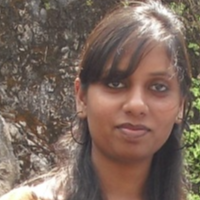
Alka Vishwa
Work place: International Institute of Management Engineering & Technology, Jaipur, Rajasthan, India
E-mail: alkavishwa09@gmail.com
Website:
Research Interests: Computer systems and computational processes, Artificial Intelligence, Neural Networks
Biography
Alka Vishwa (1986- ) was born in Ajmer, India in 1986. She received her degree of B. Tech from Rajasthan University in 2008 and currently pursuing M. Tech from Gyan Vihar University, Jaipur.
She has published over 8 refereed journal and conference papers in the areas of neural networks. Some of her representative published papers list is as follows: "Classification of arrhythmic ECG data using machine learning Techniques" published in IJCSITS, “Speckle noise reduction in ultrasound images using wavelet thresholding" published in IJARCSSE, “Modified method of pre diagnosis of lung cancer using forward ANN" published in IJCSE, “Modified method of speckle noise reduction in ultrasound images" published in IJISA. Her research interests include artificial neural networks and nanotechnology.
Author Articles
Nanotechnology Method Comparison for Early Detection of Cancer
DOI: https://doi.org/10.5815/ijisa.2013.03.06, Pub. Date: 8 Feb. 2013
Since 1999, cancer has been the leading cause of death under the age of 85 years and the eradication of this disease has been the long sought-after goal of scientists and physicians. Cancer is a disease in which abnormal cells divide uncontrollably. These abnormal cells have the ability to invade and destroy normal body cells, which is life threatening. One of the most important factors in effective cancer treatment is the detection of cancerous tumour cells in an early stage. Nanotechnology brings new hope to the arena of cancer detection research, owing to nanoparticles’ unique physical and chemical properties, giving them the potential to be used in the detection and monitoring of cancer. One such approach is quantum dots based detection which is rapid, easy and economical enabling quick point-of-care screening of cancer markers. QDs have got unique properties which make them ideal for detecting tumours. On the other hand, Gold nanoparticles have been in the bio-imaging spotlight due to their special optical properties. Au-NPs with strong surface-plasmon-enhanced absorption and scattering have allowed them to emerge as powerful imaging labels and contrast agents. This paper includes the comparative study of both the methods. Compared with quantum dots, the gold-nanoparticles are more than 200 times brighter on a particle-to-particle basis, although they are about 60 times larger by volume. Thus, Gold nanoparticles in suspension, offers advantages compared with quantum dots in that the gold appears to be non-toxic and the particles produce a brighter, sharper signal.
[...] Read more.Modified Method for Denoising the Ultrasound Images by Wavelet Thresholding
DOI: https://doi.org/10.5815/ijisa.2012.06.03, Pub. Date: 8 Jun. 2012
Medical practitioners are increasingly using digital images during disease diagnosis. Several state-of-the-art medical equipment are producing images of different organs, which are used during various stages of analysis. Examples of such equipment include MRI, CT, ultrasound and X-Ray. In medical image processing, image denoising has become a very essential exercise all through the diagnosis as Ultrasound images are normally affected by speckle noise. The noise in the image has two negative outcomes, the first being the degradation of the image quality and the second and more important, obscures important information required for accurate diagnosis.Arbitration between the perpetuation of useful diagnostic information and noise suppression must be treasured in medical images. In general we rely on the intervention of a proficient to control the quality of processed images. In certain cases, for instance in Ultrasound images, the noise can suppress the information which is valuable for the general practitioner. Consequently medical images can be very inconsistent, and it is crucial to operate case to case. This paper presents a wavelet-based thresholding scheme for noise suppression in Ultrasound images and provides the knowledge about adaptive and anisotropic diffusion techniques for speckle noise removal from different types of images, like Ultrasound.
[...] Read more.Other Articles
Subscribe to receive issue release notifications and newsletters from MECS Press journals